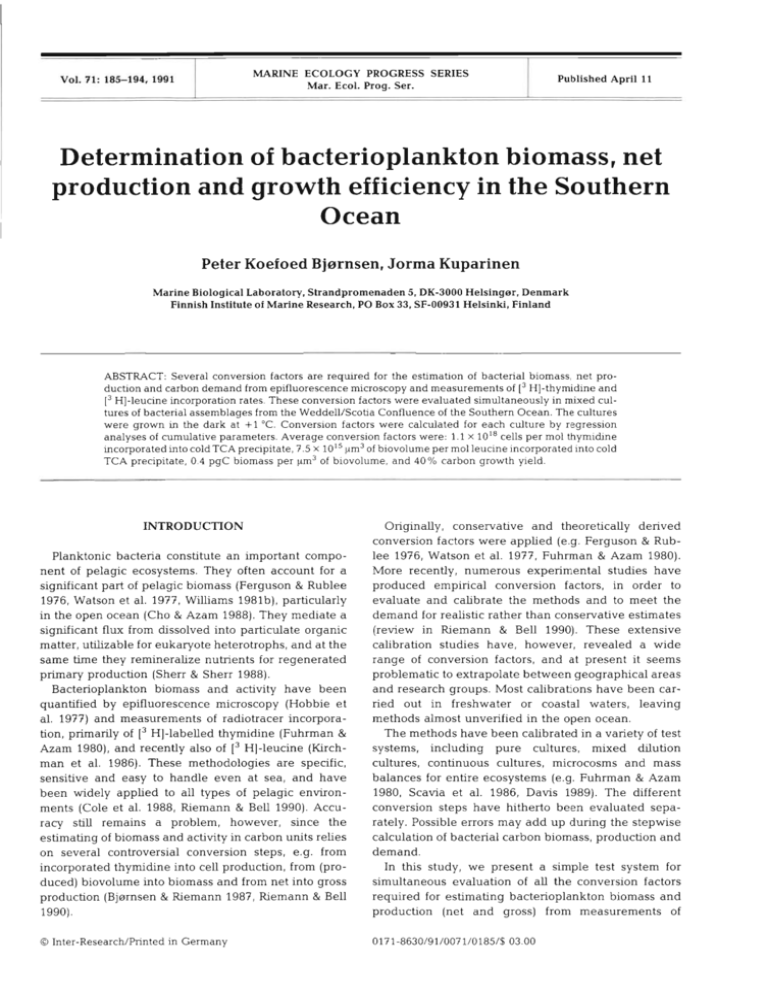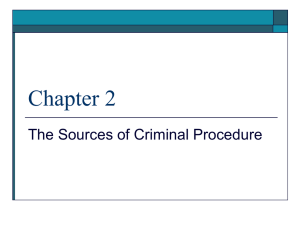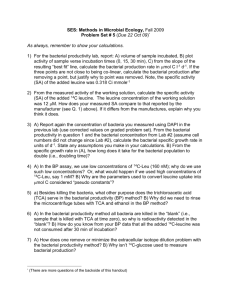Determination of bacterioplankton biomass, net production and
advertisement

MARINE ECOLOGY PROGRESS SERIES
Mar. Ecol. Prog. Ser.
Vol. 71: 185-194. 1991
1
Published April 11
Determination of bacterioplankton biomass, net
production and growth efficiency in the Southern
Ocean
Peter Koefoed Bjarnsen, Jorma Kuparinen
Marine Biological Laboratory. Strandpromenaden 5 , DK-3000 Helsinger, Denmark
Finnish Institute of Marine Research, PO Box 33. SF-00931 Helsinki, Finland
ABSTRACT: Several conversion factors are r e q w e d for the eshmation of bacterial biomass, net production and carbon demand from epifluorescence microscopy and measurements of [3 H]-thymidlne and
[3 H]-leucine incorporation rates. These conversion factors were evaluated simultaneously in mixed cultures of bacterial assemblages from the Weddell/Scoha Confluence of the Southern Ocean. The cultures
were grown in the dark at + l 'C. Conversion factors were calculated for each culture by regression
analyses of cumulative parameters. Average conversion factors were: 1.1 X 1018 cells per m01 thymidme
incorporated into cold TCA precipitate, 7.5 X 1015pm3of biovolume per m01 leucine incorporated into cold
TCA precipitate, 0 4 pgC biomass per wm3of biovolume, and 40% carbon growth yield.
Planktonic bacteria constitute an important component of pelagic ecosystems. They often account for a
significant part of pelagic biomass (Ferguson & Rublee
1976, Watson et al. 1977, Williams 1981b), particularly
in the open ocean (Cho & Azam 1988).They mediate a
significant flux from dissolved into particulate organic
matter, uthzable for eukaryote heterotrophs, and at the
same time they remineralize nutrients for regenerated
primary production (Sherr & Sherr 1988).
Bacterioplankton biomass and activity have been
quantified by epifluorescence microscopy (Hobbie et
al. 1977) and measurements of radiotracer incorporation, primarily of [ 3 H]-labelled thymidine (Fuhrman &
Azam 1980), and recently also of [ 3 H]-leucine ( I r c h man et al. 1986). These methodologies are specific,
sensitive and easy to handle even at sea, and have
been widely applied to all types of pelagic environments (Cole et al. 1988, h e m a n n & Bell 1990). Accuracy still remains a problem, however, since the
estimating of biomass and activity in carbon units relies
on several controversial conversion steps, e.g. from
incorporated thymidine into cell production, from (produced) biovolume into biomass and from net into gross
production ( B j ~ r n s e n& f i e m a n n 1987, Riemann & Bell
1990).
Originally, conservative and theoretically derived
conversion factors were applied (e.g. Ferguson & Rublee 1976, Watson et al. 1977, Fuhrman & Azam 1980).
More recently, numerous experimental studies have
produced empirical conversion factors, in order to
evaluate and calibrate the methods and to meet the
demand for realistic rather than conservative estimates
(review in Riemann & Bell 1990). These extensive
calibration studies have, however, revealed a wide
range of conversion factors, and at present it seems
problematic to extrapolate between geographical areas
and research groups. Most calibrations have been carried out in freshwater or coastal waters, leaving
methods almost unverified in the open ocean.
The methods have been calibrated in a variety of test
systems, including pure cultures, mixed dilution
cultures, continuous cultures, microcosms and mass
balances for entire ecosystems (e.g. Fuhrman & Azam
1980, Scavia et al. 1986, Davis 1989). The different
conversion steps have hitherto been evaluated separately. Possible errors may a d d up during the stepwise
calculation of bacterial carbon biomass, production a n d
demand.
In this study, w e present a simple test system for
simultaneous evaluation of all the conversion factors
required for estimating bacterioplankton biomass a n d
production (net and gross) from measurements of
O Inter-Research/Printed in Germany
0171-8630/91/007 1/0185/$ 03.00
INTRODUCTION
Mar, Ecol. Prog, Ser. 71: 185-194, 1991
186
biovolume and incorporation rates of tntiated thymidine and leucine. Calibrations were done on surface
water samples from the Southern Ocean during the
European Polarstem Study (EPOS, leg 2) in December
1988.
MATERIALS AND METHODS
Sampling and establishment of cultures. Mixed bacterioplankton batch cultures were established from 3
stations in the Southern Ocean, representing the Weddell Sea (W),the Scotia Sea (S) and the ScotiaIWeddeU
Confluence (C), which is a permanent frontal zone of
elevated biological activity. Details of sampling conditions are given in Table 1. Water samples of about 12 1
were taken by Niskin bottles and transferred to a polyethylene jar. Two batch cultures were grown from each
siativ11, one with reduceci content of dissolved inorganic carbon (Batch A, 7 l), the other with unmanipulated DIC (Batch B, 2 1). Both cultures were inoculated
with water filtered through 0.8 pm Nuclepore polycarbonate filters, in order to remove predators. The
inoculum was diluted 10 times by particle-free seawater, obtained by filtration through 0.1 pm Nuclepore
cartridge filters. For Batch A, dissolved inorganic carbon was stripped off from the particle-free water before
addition to the inoculum, by acidification to pH 4 ,
bubbling with C02-free air for about 3 h, and readjustment of pH to 8.0 with a buffer containing 100 mM
NaOH and 10 mM Na2 PO4. Less than 2 ml of buffer
was added per liter of medium, so the PO4 concentration was increased less than 10-fold above the
ambient level in the Southern Ocean of about 2pM.
Batch A was grown in a closed 10 1 glass bottle, and
samples were taken through a tubing; air let in to
replace the sample passed a 20 cm column of soda lime
C 0 2 absorber. Batch B was grown in a 2 1 polycarbonate bottle. The batches were incubated in the dark at
+ I OC, and were sampled daily for 13 d (Scotia expenment only 8 d) for determination of thymidine incorporation and cell number. Batch A was further sampled
daily for determination of leucine incorporation and
every third day for measurement of cell volume, par-
ticulate organic carbon and dissolved inorganic carbon.
[3~]-thymidineincorporation into cold TCA precipitate. Triplicate water samples of 16 ml were incubated with 10 nM of methyl-[3~]-thymidine(Amersham, 50 Ci mmol-I) for 60 min. Incubations were
stopped by 600 111 39 O/O neutral formalin. A prekilled
sample was used as blank. The samples were filtered
onto 0.22 pm cellulose acetate filters, rinsed 10 times
with 1 ml 5 YO ice-cold trichloroacetic acid (TCA) and
radioassayed on board in an LKB 1209 Rack-Beta liquid
scintillation counter, using PCS (Amersham) as scintillator. The dependence of thymidine incorporation on
incubation time and [3~]-thymidine
concentration was
assayed on the original, unmanipulated water samples
immediately after sampling. For the Scotia Sea expenment, however, this assay was done 17 d before the
batch experiment, but from the same geographical position.
[3H]-leucine incorporation into cold TCA precipitate. Triplicate water samples of 16 ml were incubated
for 60 min with 8.5 nM of L - [ 3 , 4 , ~ - ~ H ( ~ ) ] - l e u c i
(NEN, specific activity diluted to 73.6 Ci or 16.36 Ci
mmol-I). Otherwise, the procedure parallelled that
described above for measuring thymidine incorporation.
Cell counts and cell volume. Bacterioplankton cells
were counted and sized under epifluorescence microscope (Hobble et al. 1977). Water samples of 16 ml
were presewed with 0.6 ml of particle-free neutral
formalin (39 YO).Subsamples of 2 ml were mixed with 4
ml of 0.2 pm filtered demineralised water and filtered
onto black 0.2 km Nuclepore filters (25 mm diam). The
filters were covered with Acridine Orange solution
(1g 1-I). After 5 min of staining, the filters were sucked
dry, and stored in the dark. Bacteria were counted and
sized under a Leitz Dialux Laborlux D epifluorescence
microscope under blue light (filter set 12\31. Cell length
and width were measured by comparison to the globes
of a calibrated New Porton grid (Graticules Ltd). Cell
volumes were calculated according to the formula
given in Fuhrman (1981). The measures were always
taken from the inner bright edge of the cells, so the
volume estimates presented here are likely to be consewative.
Table 1. Sampling conditions for batch experiments ('B') and evaluations of isotope concentration and incubation time ('CT').
Ambient temperatures (Temp.) and chlorophyll a (Chl a) concentrations from C. Veth & G. Jaques (pers. comm.)
Experiment
Weddell Sea (B & CT)
Confluence (B & CT)
Scotia Sea (B)
(CT)
Date of sampling
22 Dec
08 Dec
27 Dec
10 Dec
1988
1988
1988
1988
Position
Temp. YC)
Chl a
(IKI1-I1
Station
Bjarnsen & Kuparinen: Bacterioplankton determinations m the Southern Ocean
ship's center of gravity, a n d analysis was canied out
only when the ship was at station.
Data handling. Conversion factors were derived by
linear regression of cumulative parameters. Thus, a
conversion factor from thymidine incorporation rate to
cell production rate was estimated for each batch as the
slope of the regression between cumulative incorporated thymidine and cell number. Similarly, conversion
factors from leucine incorporation to biovolume production, from biovolume to carbon biomass and from
gross to net carbon production (growth yleld) were
estimated from regression analyses between cumulative leucine incorporation, biovolume, POC (cumulative net carbon production) and POC+DIC (cumulative
gross carbon production).
Particulate organic carbon (POC). Triplicate 50 m1
water samples were filtered onto three 6 mm diameter
spots on a precombusted (at 500 'C) 47 mm GF/F disc
(Whatman). Two triplicate filtrations were carried out
for each sample. The filters were dried at 40 "C and
stored for combustion infrared gas analysis. The spots
containing the samples were punched out with a 9 mm
diameter hollow cork drill. A 9 mm disc was taken from
the center of the filter and used as a blank. Each disc
was combusted at 960 "C for 8 S in a flow of oxygen that
carried the produced CO2 to a Hartman-Braun infrared
gas analyser equipped with a Hewlett-Packard integrator. Pre-weighed crystals of oxalic acid were used as
a standard.
Dissolved inorganic carbon (DIC). Five replicate
subsamples of 150 p.l were injected into a chamber
containing 3 m1 of 3 O/O H N 0 3 , bubbled by a nitrogen
flow (500 m1 minp'), that c a m e d the released CO2 to a n
infrared gas analyser (ADC, model 225 MK 3). The
signal was integrated over a period of 75 S , a n d measurements were calibrated against solutions of KHC03.
The infrared gas analyser, which is sensitive to displacements and vibrations, was placed close to the
Weddell Sea
RESULTS AND DISCUSSION
Thymidine incorporation
Thymidine incorporation was proportional to incubation time for at least 2 h , and was almost constant for
Confluence
4
rnln
187
Scotia Sea
- 3
mln
rnln
Fig. 1. Dependence of [3 H]-thymidine incorporation (TT)on incubation tlme (upper row) a n d [3H]-thyn~idineconcentration
(LEU) on [3H]-leucine concentration (lower row). Vertical dotted Lines
(middle row); dependence of 1 3 ~ ] - l e u c i n incorporation
e
i n l c a t e conditions used in experiments
Mar. Ecol. Prog. Ser. 71: 185-194, 1991
188
[3H]-thymidine concentrations between 1 and 20 nM
(Fig. 1). Thus, our use of 1 h incubations and 10 nM
[3~]-thymidine
represented a choice within wide safety
margins. Since blank values are roughly proportional
to the [3H]-thymid~e
concentration (data not shown),
the sample-to-blank ratio and thereby the sensitivity of
the method could have been improved by an order of
magnitude by using 2 h incubation and 2 nM i3H]thymidine addition. The sensitivity of our procedure
was about 0.1 pM h-'.
40-
-?
0
2
O
>
.
,
0
.
.
4
.
.
.
.
8
>
.
.
.
.
12
0
4
3.8
s2
0
-L
//
::#
3
2.8
12
:F/J
0
4
8
2.8 0
4
8
3.8
E
6
+
-,
12
3
Days
Fig. 2. Time courses of [3 HI-thymidme incorporation (TIT), [3H]-leucine incorporation (LEU), cell counts (AODC), particulate
organic carbon (POC),and dissolved organlc carbon (DIC) in A-batches (-1
and B-batches ( - - - - )
Bj~rnsen& Kuparinen: Bacterioplankton determinahons in the Southern Ocean
Thyrnidine and leucine incorporation rates increased
exponentially in all batch cultures for 4 to 8 d with
increase rates of 0.5 to 1.8 d-l, and with no apparent
time lag at the beginning of the experiments (Figs. 2 &
3). Leucine incorporation rate increased more rapidly
than thymidine incorporation rate, but the difference
was significant only in the Weddell experiment. Cell
numbers increased at much slower rates (0.0 to 0.4 d-l,
data not shown), suggesting that not all cells were
acti\~e.Cell volumes increased significantly during
the first 3 d of the experiments, then stabilised or
decreased (Table 2). The proportion of rod-shaped bacteria (as opposed to cocci) increased from about 60 O/O at
the start to about 90 O/O at the end of the experiments
(data not shown). These observations also indicate
some selectivity and/or enrichment of the batches.
Increase of cell volume is often observed in response to
confinement of bacterioplankton (Ferguson et al. 1984)
and may be due to enrichment and lack of predation
(Gonzales et al. 1990).
Thymidine incorporation rate were almost similar in
the 2 types of batches (A vs B) throughout the experiments (Fig. 2). Cell numbers developed similarly in Aand B-batches for the first 7 to 10 d, but then A-batches
with reduced DIC showed rapid increases of cell numbers, particularly in the Weddell and Scotia experiments. The carrying capacity in the B-batches of about
5 to 10 pm01 organic carbon 1-' was probably not
limited by available phosphate (ca 2 FM), so it seems
unhkely that this stimulation of the A-batches was a
direct effect of the phosphate addition (C20 FM). The
acidification may, however, have hydrolyzed high
molecular weight dissolved organic compounds, which
thereby became more readily available for the bacteria.
189
Thymidine incorporation was integrated from Day 1
(Table 2) and compared by linear regression to cell
numbers (Fig. 4 ) , in order to reveal an empirical conversion factor from 13H]-thymide incorporation (TTI) to
cell production for each individual batch (Table 3).
Some data points were excluded in these regression
analyses (Fig. 4), either because cell numbers started to
l
i
0
2
6
4
8
1 0 1 2 1 4
Days
Fig. 3. Logarithmic time courses of TT1 in Batches A (-)
and
B ( - - - - ) , and of LEU in Batch A (.--..). The curves have been
placed arbitrarily in relation to the ordinate to facilitate visual
separation
Table 2. Integrated [ 3 ~ ] - t h y m i ~and
n e [3H]-leucineincorporation (ZTTI and ZLEU), cell counts and volumes (AODC and Vol),
and particulate organic carbon and dissolved inorganic carbon (POC and DIC) from the batch experiments (Batch A with reduced
DIC content, Batch B unmanipulated)
Experiment
Day
X?TI
(nM)
Weddell
Confluence
Scotia
-
ZLEU
(nM)
0.8
18.0
159.3
352.4
1
4
7
10
13
0.02
0.24
1.23
1.82
1
4
7
10
13
0.03
0.62
1.30
2.36
0.2
13.0
20.6
36.0
1
4
8
0.25
1.03
3.7
57.1
-
-
-
Batch A
AODC
Vol
(m3)
( l 91 )
POC
1-l)
DIC
(W 1-7
Batch B
ZlTI
AODC
(nM)
(log l-l)
0.10
0.10
0.94
7.40
7.46
0.076
0.100
0.122
0.107
0.092
46
39
96
397
390
2845
2890
3000
3350
3445
0.07
0.52
1.37
2.06
0.11
0.35
0.89
1.56
1.88
0.07
0.16
0.81
1.35
2.30
0.079
0.153
0.146
0.136
0.136
61
45
124
150
158
ND
ND
ND
ND
ND
0.07
0.75
1.66
2.55
0.06
0.13
0.75
1.19
1.32
1.06
1.21
5.12
0.114
0.165
0.143
68
93
279
3095
3205
3470
0.23
0.76
1.01
1.13
1.32
190
Mar. Ecol. Prog. Ser. 7 1: 185-194, 1991
Confluence
Scotia
Fig. 4. Regression of cumulative parameters (A-batches: -,
B-batches:
Point labels refer to sampling days. Numbers in
upper left of each box give slopes of linear regressions representing conversion factors from Tn to cell production (10" cells
~
mol-' ) , from biovolume to carbon biomass (pg C ~ r n - and
~ ) from gross to net
mol-'1, from LEU to biovolume production ( 1 0 ' km3
carbon production (carbon growth yield)
Bjernsen & Kuparinen: Bacterioplankton determinations in the Southern Ocean
decrease, or because cell numbers showed rapid
increases that were apparently not reflected in the TT1
measurements (Fig. 2). The regression analyses produced conversion factors that differed significantly
from each other (Table 3). In particular, 2 batches, W-A
and C-B (3.18 and 0.65 X l0I8 cells mol-l, respectively),
deviated remarkably from the remaining 4 batches,
where the conversion factors clustered around a mean
value of 1.12 X 1018cells mol-l. The overall average for
all batches was 1.37 X 10" cells mol-l. These values
are consistent with empirical conversion factors found
in subtropical and temperate marine waters. Thus
Fuhrman & Azam (1982) and Riemann et al. (1987)
found conversion factors of 1.1 to 1.4 X l o l ' cells mol-'
[3 H]-thymidine incorporation into macromolecular
material. In the latter study, 3 out of 65 values were,
however, significantly higher: about 3.8 to 5.8 X 10''
cells mol-l. firchman & Hoch (1988) anived at a conversion factor of 1.0 X 1018 cells mol-'. Higher conversion factors have been obtained in freshwater (e.g. Bell
et al. 1983, Lovell & Konopka 1985, Smits & Riemann
1988, Riemann & Bell 1990),particularly at high growth
rates (Smits & Riemann 1988). Coveney & Wetzel
(1988) found that conversion of thymidine incorporation into bacterial biovolume production was less variable than conversion into cell production in oligotrophic lake water cultures. In this study, conversion
factors of 6.44, 1.26 and 5.25 X 10'' pm3 mol-' were
derived from the Weddell, Confluence and Scotia
experiments, respectively. The first and last values are
very close to the average of 5.54 X 1017 pm3 mol-'
found by Coveney & Wetzel (1988), while the result
from the Confluence experiment was significantly
lower.
Different calculation protocols have been applied to
191
extract empirical conversion factor from simultaneous
measurements of cell number increase and thymidine
incorporation in dilution cultures of bacterioplankton.
Fuhrman & Azam (1980, 1982) directly compared cell
number increase over 24 h to the initial thymidine
incorporation rate, assuming constant incorporabon
rate throughout the experiment. Kirchman e t al. (1982)
introduced a derivative calculation method based on
regression analysis of logarithmic plots against time,
assuming that all cells grow exponentially a n d at a
similar rate. Riemann et al. (1987) calculated the conversion factor a s cell number increase divided by integrated thymidine incorporation during a given period.
This integrative method is model-free, but does not
fully exploit the data set; only start and end cell
numbers are utilized and therefore need to be very
precisely determined.
In this paper, w e have used what could be called a
cumulative method, based on a direct regression
between integrated values, in this case cell number
a n d integrated thymidine incorporation. This method
combines the advantages of the derivative a n d integrative methods: it extracts maximum information from
the data set (all data points are considered in the
regression analysis), with a minimum of presumptions
(no growth model is required since the time parameter
is cancelled out). The constancy of the conversion factor during the experiment can easily be verified from
the linearity of the regression plot (Fig. 4), as expressed
by the regression coefficient (Table 3).
Leucine incorporation
The determination of bactenoplankton production
from measurements of ~ ~ H l - l e u c i nincorporation
e
into
Table 3. Conversion factors derived by linear regression of cumulative parameters, cf. Fig. 4. Conversion factors (CF), standard
errors (*SE), number of data points (n) and regression coefficients (r2)are given for each experiment. W: Weddell; C: Confluence;
S: Scotia
Conversion factor (unit)
Expt
CF
(-C SE)
n
r2
TT1 to cell product~on
(1018cells mol-l)
W-A
W-B
C-A
C-B
S-A
S-B
3.18
1.33
0.91
0.65
1.00
1.23
( t0.10)
( t0.17)
( +0.03)
( t0.04)
( t0.37)
( + 0.18)
8
9
11
11
7
7
0.99
0.90
0.99
0.96
0.60
0.90
LEU Biovol. prod.
(l0I5 um3 mol-')
W-A
C-A
S-A
4.90
8.31
9.51
( + 0.09)
( 0.24)
(k 0.21)
4
5
3
0.99
0.99
0.90
Biovol. to C biomass
(pg C ~ m - ~ )
W-A
C-A
S-A
0.45
0.37
0.35
( + 0.01)
4
5
3
0.99
0.84
0.99
Carbon growth yield
(c/c)
W-A
S-A
0.40
0.38
( 0.02)
( + 0.04)
5
3
0.99
0.99
+
( 2 0.10)
( t0.01)
+
Mar. Ecol. h o g . Ser. 71: 185-194, 1991
192
bacterial protein has been introduced as an alternative
to the now widely used [3H]-thymidine incorporation
(TTI) method. Theoretically, thymidine is mainly incorporated into DNA, which is closely related to cell
number, while leucine is mainly incorporated into protein, which is related to biomass. Thus, the leucine
method seems to offer an attractive shortcut to an
estimate of bacterial carbon production, compared to
the stepwise conversion of thymidine incorporation via
cell production and biovolume production.
On the other hand, several methodological aspects of
the leucine method still appear problematic. Often, a
high external concentration of [3H]-leucineis required
to saturate incorporation (Fig. 1; Kirchman et al. 1986,
Kirchman & Hoch 1988). This indicates that de novo
synthesis of leucine takes place to a considerable
extent, as also shown directly by Simon and Azam
(1988), and the use of hlgh [3H]-leucine concentrations
increases the risk that organisms other than bacteria
may incorporate the tracer. The constancy of leucine
m01 percentage in bacterial protein [Hagstrijm et al.
1984 (8.3 to 9.1 %), Simon & Azam 1988 (7.3 to 1.9 %, n
= 47)] also needs verification from a wider range of
aquatic environments. In this study, extraction in cold
TCA instead of boiling TCA (Sirnon & Azam 1988) was
chosen for practical reasons. Chin-Leo & Kuchman
(1988) found no difference between the 2 procedures.
The available information on empirical conversion
factors for leucine incorporation to bacterial production
is much more limited than for thymidine incorporation,
and only a few studies convert into biovolume or biomass rather than to cell production. Simon & Azam
(1988) found a conversion factor to biomass production
of 3.1 kgC mol-' (assuming isotope dilution of 2 and C/
protein = 0.86 wt/wt), which is almost identical to the
average of our conversion factors (7.5 X 1015km3 mol-'
X 0.4 pgC
= 3.0 kgC mol-l). Kirchman et al.
(1986) obtained conversion factors of 1.1 to 9.5 kgC
mol-' from leucine incorporation rates at [ 3 ~ ] - l e u c i n e
concentrations of 10 nM or at saturation.
Cell carbon
The regression analyses of POC versus biovolume
revealed a n average conversion factor of 0.4 pgC
The traditionally used carbon densities of 0.086 to 0.121
pgC
(Ferguson & Rublee 1976, Watson et al.
1977) have been criticised for their general lack of
empirical foundation (Bjemsen & fiemann 1987), and
specifically for not addressing the problem of intercellular water when determining dry-to-wet-weight ratios
(Bratbak & Dundas 1984). Several recent studies have
related biovolumes to directly measured carbon biomasses, revealing a wide range of empirical conversion
factors [e.g. 0.56 pgC pm-3 (Bratbak 1985), 0.11 pgC
(Nagata 1986), 0.35 pgC pm-3 (Bjemsen 1986a
and 0.38 pgC pm-3 (Lee & Fuhrman 1987)l. A calibration study in several pelagic environments using the
same sizing procedure as in this study produced an
average carbon density of 0.38 pgC pm-3 (Salonen et
al. unpubl.). The variability in empirical carbon-tovolume ratios is probably caused primarily by the inherent subjectivity in microscopic sizing of bacterial cells.
The comparability of the empirically found carbon
densities could be improved by an intercalibration
among the laboratories involved.
Growth yield
Carbon growth yields of 0.40 and 0.38 were estimated for the Weddell and Scotia experiments. Unfortunately, the infrared gas analyser was not in operation
during the Confluence experiment. The literature on
bacterioplankton growth yield is characterized by controversy. The high uptake efficiencies (50 to 90 %)
found after short incubations of bacterioplankton with
radolabelled substrates (Williams 1984) reflect assimilation efficiencies rather than growth efficiencies
(Bjemsen & Fbemann 1987). Growth efficiencies of 10
to 30 % have been estimated from comparisons of
bacterial net production with either respiration or substrate consumption (refs, in Bjemsen 1986b). Most of
these estimates, however, are indlrect and rely on other
conversion factors, and particularly net production may
have been underestimated by using conservative carbon densities. A comparison of POC and DIC production in continuous cultures of bacteria from a Danish
estuary (Bjemsen 1986b) revealed a growth yield of
21 %, while a regression analysis of pelagic community
respiration in the same estuary suggested a bacterial
growth yleld of 42 % (Jensen et al. 1990). Bacterioplankton growth yield is a crucial parameter for the
establishment of pelagic carbon budgets. If a low bacterial growth yield (e.g. < 25 O/O) is assumed, it becomes
difficult to accomplish bacterioplankton carbon
demand by autochtonous sources (review by Cole et al.
1988). On the other hand, a high bacterial growth yield
( > 5 0 %) is inconsistent with the observations of bacterioplankton being responsible for more than half of
the pelagic community respiration (e.g. Williams
1981a, Schwaerter et al. 1988, Jensen et al. 1990).
The test system
The test system described in this paper allowed
simultaneous evaluation of all the conversion factors
required to convert thymidine (TT'I) and leucine (LEU)
B j ~ r n s e n& Kuparinen: Bactenoplankton determinations in the Southern Ocean
cell volume
IBiovol. pr*
1
0.4 pgC pm-3
I C net prod.
2.5~
4.5 kgC mol-l
-
--
JCIgr o g prod1
l ,5
&'C respiratior
""i
Fig. 5 Summary of average empirical conversion factors found
in this study from [ 3 ~ ] - t h y r n i d nincorporation
e
(TTI) and [3H]leucine incorporahon (LEU) into bacterial production, carbon
demand and respiration
incorporation into bacterial net production, carbon
demand and respiration (Fig. 5). The obtained empirical conversion factors are consistent with experiences
from temperate and subtropical coastal waters. For the
TT1 method we suggest a conservative conversion factor of 1.1 X 10'' cells mol-l, noting that this value may
occasionally underestimate bacterial net production.
The carbon density of 0.4 pgC pm-3 probably depends
on the cell sizing procedure and should only be applied
to other procedures after proper intercalibration.
The conversion of leucine incorporation to biovolume
or biomass production (3.0 kgC mol-l) represents a n
attractive shortcut in avoidlng cell sizing, but
experiences with this method are still limited. High
saturation concentrations of leucine represent a potential methodological problem. At present the leucine
incorporation method therefore appears more as a supplement than as a n alternative to the TT1 method.
The conversion of net production into gross production and respiration by assuming a carbon growth yleld
of 40 O/O appears as a realistic compromise among the
conflicting literature values of 10 to 70 % . The conversion of carbon respiration into oxygen consumption is
relevant for comparisons to measured oxygen consumption rates and for establishing oxygen budgets,
but unfortunately little is known about respiratoric
quotients of the utilizable dissolved organic compounds in pelagic environments.
Any test system based on fractionation and confinement may selectively alter the growth conditions (Ferguson et al. 1984, Coveney & Wetzel 1988), and therefore manipulations and incubation time should be kept
at a minimum. In this study w e tried to design the test
system to be as simple as possible. The relatively long
duration of the experiments was required at the low
temperatures, and the CO2 removal in the A-batches
was necessary to achieve sufficient precision of the DIC
measurements. The bacteria responded to the manipulations by active growth, whlch made it possible to
193
extract empirical conversion factors. Similar thymidine
conversion factors were denved from A- and B-batches,
despite the observed differences in bacterial growth.
There is need for further calibration of the thymidine,
leucine and fluorochrome methods, particularly in
oceanic environments, before bacterioplankton production and biomass can be assessed on a routine
basis. The consistency of our results with the literature
on calibrations in coastal waters does, however,
strongly support the usefulness and reliability of the
tested methods, even in the - from any point of view extreme environment of the Southern Ocean.
Acknowledgements. The experiments were carried out during
the European 'Polarstern' Study (EPOS) sponsored by the
European Science Foundation and the Alfred Wegener Institute for Polar and Marine Research, Germany. Addtional
financial support was offered by the Danish Natural Research
Council (to P.K.B.) and by the Finnish Ministry of Trade and
Industry (to J.K.).Wallach Inc. put a liquid scintillation counter
at our disposal dunng the cruise. MS Ellina Salminen provided
technical assistance.
LITERATURE CITED
Bell, R. T., Ahlgren, G. M., Ahlgren, I. (1983). Estimating
bacterioplankton produchon by measunng [ 3 ~ ] - t h y m i d n e
incorporation in a eutrophic Swedish lake. Appl. environ.
Microbiol. 45: 1709-1721
B j ~ r n s e n P.
, K. (1986a). Automatic determination of bacterioplankton biomass by means of lmage analysis. Appl. environ. Microbiol. 51: 119-1204
Bjornsen, P. K. (1986b). Bactenoplankton growth yleld in
continuous seawater cultures. Mar. Ecol. Prog. Ser. 30:
191-196
Bjornsen, P. K., Riemann, B. (1987). Towards a quantitahve
stage in the study of microbial processes in pelagic carbon
flows. Arch. Hydrobiol. Beih. 31: 185-193
Bratbak, G. (1985). Bacterial biovolume and biomass estimations. Appl. environ. Microbiol. 49: 1488-1493
Bratbak, G., Dundas, I. (1984). Bacterial dry matter content
and biomass estimations. Appl. environ. Microbiol. 48:
755-757
Chin-Leo, G., k r c h m a n , D. L. (1988). Estimating bacterial
production in manne waters from the simultaneous incorporation of thyrnidine and leucine. Appl. environ. Microbiol. 54: 1934-1939
Cho, B. C., Azam, F. (1988). Major role of bacteria in
biogeochemical fluxes in the ocean's interior Nature,
Lond. 332: 4 4 1 4 4 3
Cole, J. J., Findlay, S., Pace, M. (1988). Bacterial production in
fresh and saltwater ecosysten~s:a cross-system overview.
Mar. Ecol. Proq. Ser. 43: 1-10
Coveney, M. F., Wetzel, R. G. (1988). Experimental evaluahon
of conversion factors for the 3H-thvmidme incomoration
assay of bacterial secondary production. Appl. environ.
Microbiol. 54: 2018-2026
Davis, C. L. (1989). Uptake and incorporation of thymidne by
bacterial isolates from a n upwelling environment. Appl.
environ. Microbiol. 55: 1263-1272
Ferguson, R. L., Buckley, E. N , Palumbo, A. V. (1984).
Response of marine bactenoplankton to differential filtration and confinement. Appl. environ. Microbiol. 47: 49-55
-
194
Mar. Ecol. Prog. Ser. 71: 185-194, 1991
Ferguson, R. L., Rublee, P. (1976). Contribution of bacteria to
standing crop of coastal plankton. Limnol. Oceanogr. 22:
141-145
Fuhrman, J. A. (1981). Influence of method on the apparent
size distribution of bacterioplankton cells: epifluorescence
microscopy compared to scanning electron rnicroscopy.
Mar. Ecol. Prog. Ser. 5: 103-106
Fuhrman, J. A., Azam, A. (1980). Bacterioplankton secondary
production estimates for coastal waters off British Columbia, Antarctica and California. Appl. environ. Microbiol.
39: 1085-1095
Fuhrman, J. A., Azam, F. (1982). Thymidine incorporation as a
measure of heterotrophic bacterioplankton production in
marine surface waters: evaluation and field results. Mar.
Biol. 66: 109-120
Gonzales, J. M., Sherr, E. B., Sherr, B. F. (1990). Size selective
grazing on bacteria by natural assemblages of estuarine
flagellates and ciliates. Appl. environ. Microbiol, 56:
583-589
Hagstr6m. P\., Ammerman, J. W., Heinrichs, S.. Azam, F.
(1984). Bacterioplankton growth in seawater. 11. Organic
matter utilization during steady state growth in seawater
cultures. Mar. Ecol, Progr. Ser 18: 41-48
Hobbie, J. E., Daley, R. J., Jasper, S. (1977).Use of Nuclepore
filters for counting bacteria by fluorescence microscopy.
Appl. environ. Microbiol. 33: 1225-1228
Jensen, L. M., Sand-Jensen, K., Marcher, S., Hansen, M.
(1990). Plankton community respiration along a nutrient
gradient in a shallow Danish estuary. Mar. Ecol. Prog. Ser.
61: 75-85
Kirchman, D., Ducklow, H., Mitchell, R. (1982). Estimates of
bacterial growth from changes in uptake rates and biomass. Appl. environ. Microbiol. 44: 1296-1307
Kuchman, D. L., Hoch, M. P. (1988). Bacterial production in
the Delaware Bay estimated from thymidine and leucine
incorporation rates. Mar. Ecol. Prog. Ser. 45: 169-178
Kirchman, D. L., Newell, S. Y., Hodson, R. E. (1986). Incorporation versus biosynthesis of leucine: implications for
measuring rates of protein synthesis and biomass production by bacteria in marine systems. Mar. Ecol. Prog. Ser.
32: 47-59
Lee, S., Fuhrman, J. A. (1987). Relationship between
biovolume and biomass of naturally derived marine bacterioplankton. Appl. environ. Microbiol. 53: 1290-1303
Lovell, C. R., Konopka, A. (1985). Seasonal bacterial production in a dimictic lake as measured by increases in cell
numbers and thymidine incorporation. Appl. environ. Microbiol. 49: 492-500
Nagata, T. (1986). Carbon and nitrogen content of natural
planktonic bacteria. Appl. environ. Mcrobiol. 52:
28-32
Remann, B., Bell, R. T. (1990). Advances in estimating bacterial biomass and growth in aquatic systems. Arch. Hydrobiol. 118: 385-402
Riemann, B., Bjmnsen, P, K., Newell, S., Fallon, R. (1987).
Calculation of cell producction of coastal marine bacteria
based on measured incorporation of i3 H]-thymidine. Limnol. Oceanogr. 32: 471-476
Scavia, D., Laird, G, A., Fahnenstiel, G. L. (1986).Production
of planktonic bacteria in Lake Michigan. Limnol.
Oceanogr. 31: 612-626
Schwaerter, S., Ssndergaard, M., Remann, B., Jensen, L. M.
(1988). Respiration in eutrophic lakes: the contribution of
bacterioplankton and bacterial growth yleld. J . Plankton
Res. 10: 515-531
Sherr, E.. Sherr. B. (1988). Role of microbes in pelagic food
webs: a revised concept. Limnol. Oceanogr. 33:
1225-1 227
Simon, M,, Azam. F. (1988). Protein content and protein synthesis rate of planktonic bacteria. Mar. Ecol. Prog. Ser. 51:
201-213
Smits, J. D., Riemann, B. (1988). Calculation of cell production
from [3 H]-thymidine incorporation with freshwater bacteria. Appl. environ. Microbiol. 54: 2213-2219
Watson, S. W., Novitsky, T. J., Quinsby, H. L., Valois, F. W.
(1977). Determination of bacterial number and biomass in
the marine environment. Appl. environ. Microbiol. 33:
940-946
Williams, P. J. leB. (1981a). Microbial contribution to overall
marine plankton metabolism: a direct measurement of
respiration. Oceanologica Acta 4: 359-364
Williams, P. J. leB. (1981b). Incorporahon of microheterotrophic processes into the classical paradigm of the marine
food web. Kieler Meeresforsch., Sonderh. 5: 1-28
Williams. P. J. leB. (1984). Bacterial production in the marine
food chain: the emperors new suit of clothes? In: Hobbie, J.
E., Williams, J. P. leB. (eds.)Heterotrophic processes in the
sea. Plenum Press. New York, p. 271-279
This article was submitted to the editor
Manuscript first received: June 11,1990
Revised version accepted: January 25, 1991






